2020 certainly was a year to remember, or perhaps forget on the other side of the coin. I can’t add much more to what has already been covered, except the personal note. Now home in NZ for longer than I was overseas, I’m well pleased to have chosen to return to a wee country isolated at the bottom of the world that is just that little bit behind the times – a positive boon when a pandemic rears its head. Seven weeks of isolation, working from home, was plenty – I managed just enough riding and running locally to stay relatively sane, but working was not the most productive as I found that difficult to adjust to. Still, we’ve had it far better here than many places and that’s fairly easy to remember as I think of friends and family on distant shores.
Despite the interruption, it was another cracking year of riding bikes. An optimistic weekend loop around Waikaremoana and Whirinaki Forest Park with Pete got things off to a suitable start, the Moerangi Track always a highlight.
 Whirinaki Forest Park
Whirinaki Forest Park
February kicked off with joining Pete for his North Island Traverse; I figured riding for three hilly days was the best way to get to the west of the North Island, and riding home from East Cape similarly the obvious solution. So a big triangular, double traverse of the island ensued in which I proved to myself that I could consistently ride two hundred kilometres a day for over a week and still thoroughly enjoy myself seeing new places; kind weather certainly helped.
 First day heading west, a detour off the much less interesting Napier-Taihape Gentle Annie Road.
First day heading west, a detour off the much less interesting Napier-Taihape Gentle Annie Road.
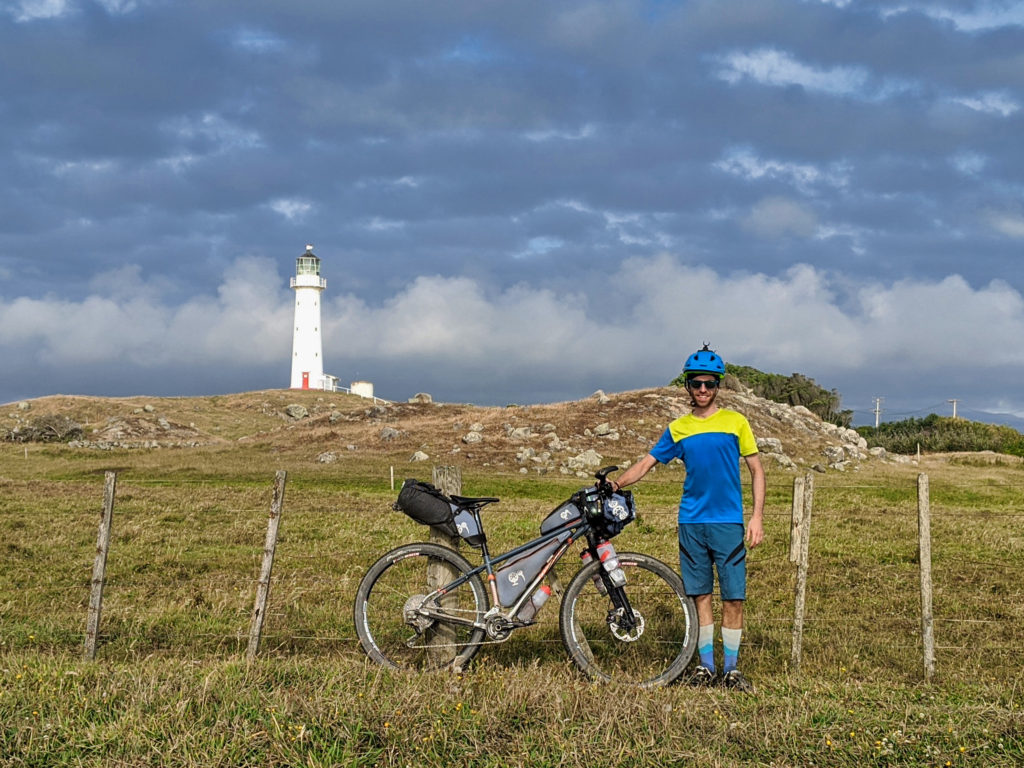 Cape Egmont, western most point.
Cape Egmont, western most point.
 Pete heading through the rural hills of Taranaki.
Pete heading through the rural hills of Taranaki.
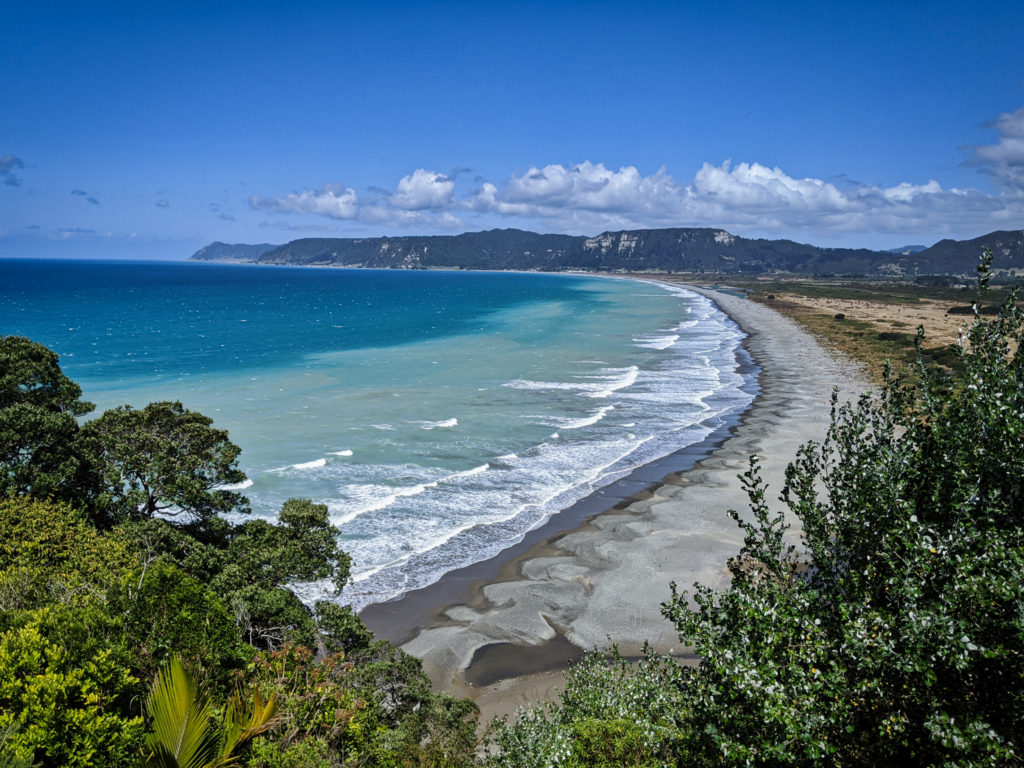 Approaching East Cape and a heinous headwind.
Approaching East Cape and a heinous headwind.
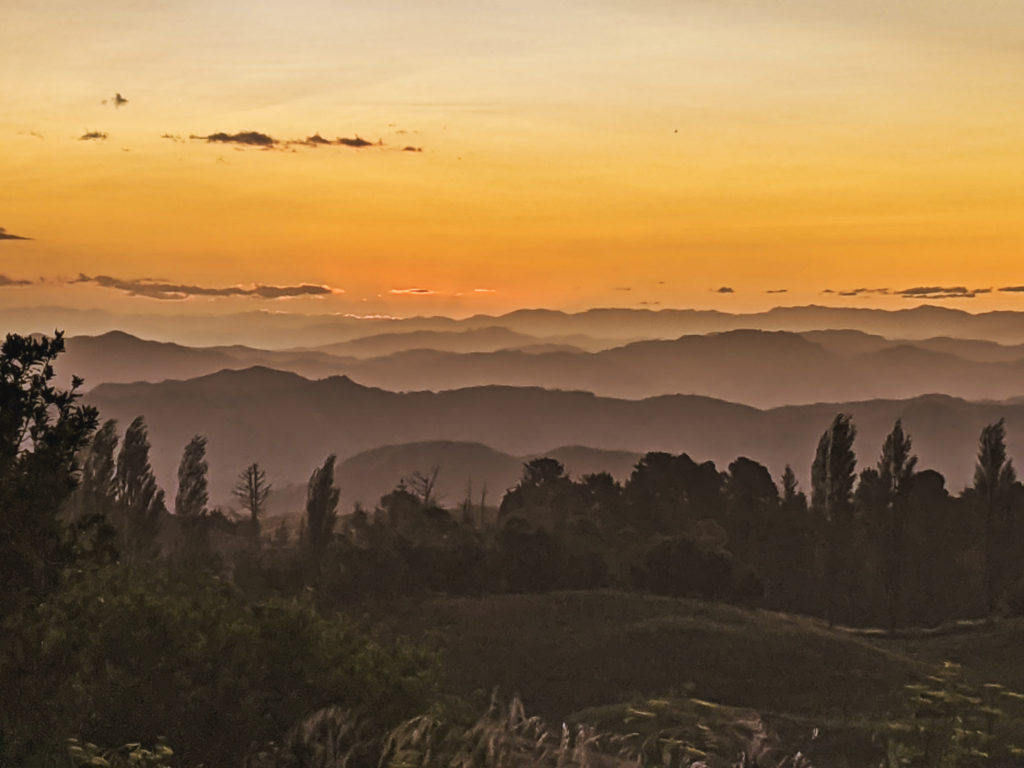 Looking towards Waikaremoana on the last night while heading for home.
Looking towards Waikaremoana on the last night while heading for home.
That experience convinced me to finally bite the bullet and book tickets for a more ambitious bikepacking proposition abroad. Alas, that couldn’t have happened this year – but I found myself not at all disappointed. Instead, with five weeks of annual leave suddenly spare and much flight credit it’s been a perfect opportunity to make the most of being in NZ and being able to see family and friends that would have been neglected if Plan A had been possible.
 Local exploration continued when allowed, this little province continuing to fascinate me – mostly with its hills and rivers.
Local exploration continued when allowed, this little province continuing to fascinate me – mostly with its hills and rivers.
Bike exploration out of the equation during lockdown, I finally took to running around the hill I live on. I gradually strung an optimised route together to link all of the thirty staircases and ramps – after a few weeks of working up to it, I was pleased to run between, and mostly walk up/down, them all on a fifteen kilometre course.
 Nope, not a bad spot to be stuck for seven weeks; the weather was brill too.
Nope, not a bad spot to be stuck for seven weeks; the weather was brill too.
Once allowed out again, I was itching to explore some of the local trails that I’d never got around to seeing as biking is not permitted there. There followed a series of small trail runs in quiet and isolated native forest. I was fascinated by getting yet another different perspective of areas I’ve biked through many times.
 Bell Rock, only very windy and with enough snow around to make things interesting.
Bell Rock, only very windy and with enough snow around to make things interesting.
Park Run took a bit of a backseat for most of the year, but with much time away getting tiring I’m back into a bit more of a routine but struggling to find my former speed with only one sub-twenty minute five kilometre run for the year. I thought I’d reach my half-century mid-year, alas … I may just sneak in by year-end.
August had a hastily organised week down south visiting family – mostly so I didn’t completely miss all of the first year of my nephew’s life. I didn’t even take a bike (!), but with little snow around I managed daily mountain-biking rides with James and ran a prickly rogaine with Adele. Mum also visited for our birthdays late-August, we enjoyed a long weekend on Mahia Peninsula – a favourite place of mine in Hawke’s Bay that it took me too long to discover. Highlights were bush walks in unrideable places, the extensive nikau grove at Maruia and a week spot of caving. Planning for this year’s Hawke’s Bay Anniversary Tour late October was not nearly as involved as for the inaugural one last year, but still required some delightful rides in different parts of Hawke’s Bay.
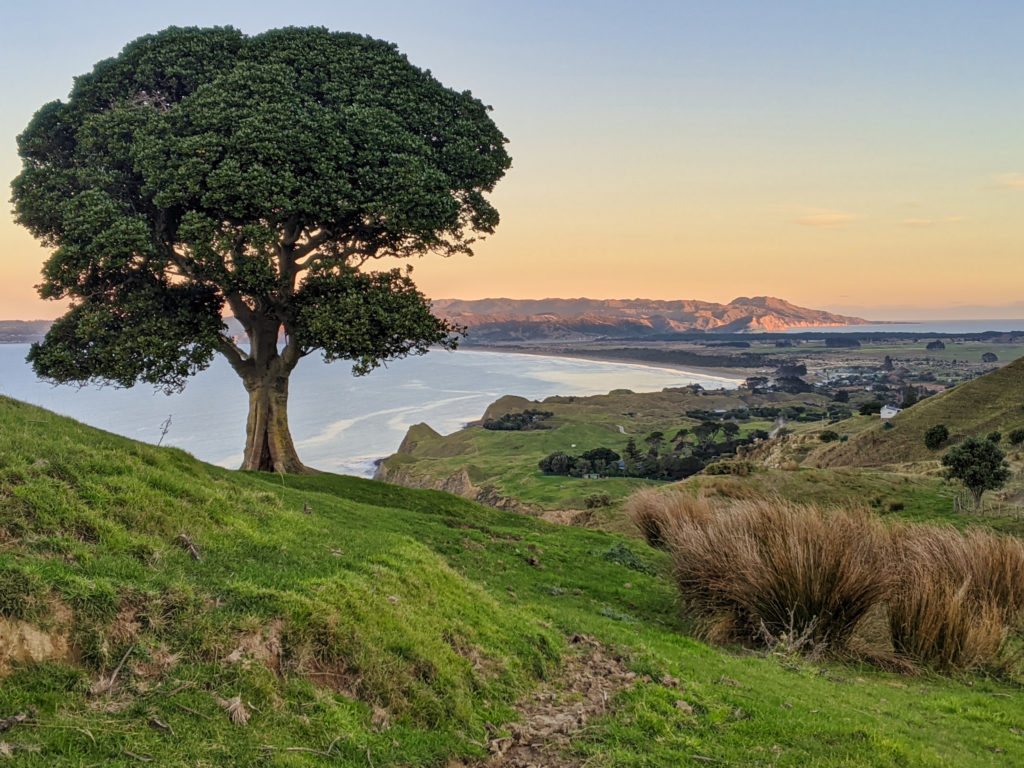 Mahia Peninsula, mid-winter.
Mahia Peninsula, mid-winter.
I was excited to share Whirinaki (the forest park, not the one where I work) with some workmates for a late-winter weekend of bushwalking and a little mountain-biking. I must get back there for longer – but where is the time?!

A small bikepacking event at the end of September finally got me to Golden Bay. The weather completely packed up after the first day of two, and I ended up sheltering from the storm for the second day – and the next two. As I had two weeks off work, it worked well sitting out the foul weather and making the most of the good weather as I toured around the West Coast – spending time with new friends, riding three world class trails and soaking in the stunning scenery.
 The calm before the storm on Six Corners event, around Golden Bay.
The calm before the storm on Six Corners event, around Golden Bay.
 Just an hour or so of pushing through the snow on the Heaphy.
Just an hour or so of pushing through the snow on the Heaphy.
 Back to Waiuta – a favourite from Kiwi Brevet and Tour Aotearoa.
Back to Waiuta – a favourite from Kiwi Brevet and Tour Aotearoa.
 The second time on the Old Ghost Road in five days, this time an out and back to the high point, the first a big through ride starting and ending in Westport on the Monday. Great weather, big views and fabulous riding both times.
The second time on the Old Ghost Road in five days, this time an out and back to the high point, the first a big through ride starting and ending in Westport on the Monday. Great weather, big views and fabulous riding both times.
As relaxing as that tour was, in hindsight leaving two weeks between that and putting the finishing touches on HBAT was not enough. My HBAT ride didn’t go well, and it took me some weeks before I wanted to go bikepacking again – which was concerning as the summer approached, along with it two big rides early next year. However, the desire to ride all sorts of places and see new things did return after a few weeks of taking it easy and looking after myself a bit more.

An unexpected element of the year was being asked to contribute some of my Hawke’s Bay bikepacking knowledge to a guidebook of shorter (<500 km) routes all around the country. Long video calls with Jonathan ensued discussing route possibilities and bikepacking in general. Somehow two routes I described ended up with full write-ups and another gets in with a brief description. I'm quite honoured and pleased by that - some actual use to all my exploring around here.
I also managed to hurriedly proofread the whole thing just before it went to press – excited by all the places I haven’t yet ridden yet doesn’t begin to describe the feeling from reading a softcopy. Now that some actual copies have arrived wrapped and are under my little Christmas tree (got to put something under there!), I’m itching to get out and ride more new places. A little final scouting ride with a small group from Wellington just as the book was going to press was another highlight of the year. If you’ve any interest in Bikepacking Aotearoa, I suggest you get a copy quickly.
The desire to try and make the most of the freedoms we are currently privileged to have lives on, spurred on not just by the global situation but also the sudden passing of two people only a matter of years younger than me in separate motorbike accidents a few days apart. In doing so, I realise I’ve had overnight trips away the last five weekends, and really am just scratching the surface of places I want to explore nearby. It’s just as well that painting and general house maintenance is now at the stage, after five years, where nothing is pressing enough to curtail weekend adventures.
 At long last spending time in the Kawekas, instead of the the edge.
At long last spending time in the Kawekas, instead of the the edge.
Airbnb for me went the way of much this year, stopping with lockdown and, with no large travel or house expenses looming, not returning yet; I’ve enjoyed the break from the work involved in having guests continually through – it served a purpose for a time, but a year off from it is grand. I still happily welcome fascinating and lovely cycle tourists, but they are few and far between now. Work continues to go well and having a good, stable employer through such a year is another reason to be thankful. I inadvertently had my role expanded and got, what I’m told was, a promotion as my manager moved up the ladder and, as the only one who has any idea what I’m supposed to be doing, dragged me up a bit too.
To my surprise (I’ll believe it when the house is full), my immediate family has decided Christmas is at my house this year – so that’ll be different and I’m looking forward to that, once I’ve caught up on the many neglected little jobs. It’ll be strange having so much time off work and staying at home, but good not to have to travel south as I’ll be doing that late January and late February for two bikepacking events. The first is the next iteration of the toughest one I’ve ever done (different route), but I’ll have to take it easy as only two weeks later is the inaugural Tour Te Waipounamu – which I’m sure will quickly take the mantle of hardest event I’ve attempted. With so much new country to see, it’s proper exciting.
Proofreading all that, it really hasn’t been that bad a year here – just a bit mad in parts. Even so, I’m looking forward to a better and more settled 2021 – I hope yours is too. Merry Christmas all, and thanks for reading this far.
Postscript: Fortunately, I found the time to write that above last week (typing is now difficult) – as life can change so quickly, which is all the more reason to make the most of whatever opportunities are available. Just about to start applying the second coat of deck stain yesterday morning, I too-enthusiastically reached for something, heard my poor shoulder tear apart and dislocate again. Thus started six hours of cycling through discomfort, pain, and agony – increasingly drug-addled for the time it took four doctors to attempt to get it back in. With a very busy Emergency Department, eventually they knocked me out completely and relocated it.
So now I’ve finished work a bit earlier for the year and, wonderfully, my parents arrived yesterday afternoon and I’m being well looked after. Hard to say where to from here, that’s six dislocations now – two in the last two years since surgery over eight years ago; I guess another round of MRIs and I might be more receptive to further surgery – because it really was a quite innocuous movement yesterday. So a more subdued Christmas is to be had, but that’s ok as the shoulder situation is only a little dip down (been here before) in my wee life c.f. this rather crazy and ever-changing world, plus I’ll get to spend a lot of time with my family over the next fortnight – although hugs and picking up my young nephew are and will be difficult.
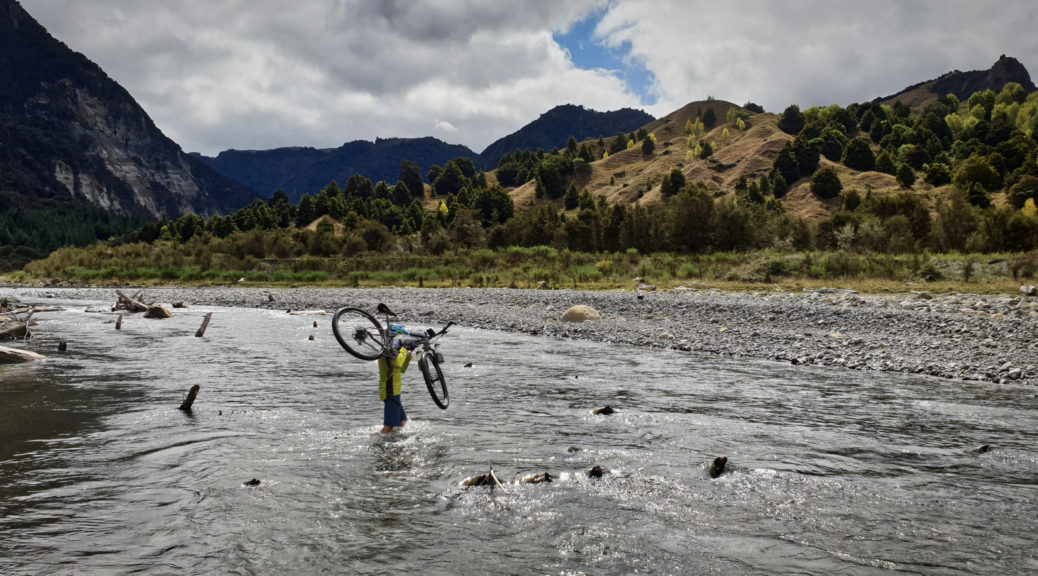
 Flying into Dunedin, Naseby nestled over yonder in front of the Ida Range.
Flying into Dunedin, Naseby nestled over yonder in front of the Ida Range. The Rock and Pillars completely devoid of snow – glad I didn’t bother to bring my skis down.
The Rock and Pillars completely devoid of snow – glad I didn’t bother to bring my skis down. Plenty of rocks to negotiate; smoke from a burn-off drifting lazily down the Taieri Valley.
Plenty of rocks to negotiate; smoke from a burn-off drifting lazily down the Taieri Valley.
 Naseby Forest.
Naseby Forest. The Clutha flowing through Alexandra.
The Clutha flowing through Alexandra. Such an unusual landscape for NZ; all those trails…
Such an unusual landscape for NZ; all those trails… We may have snuck in a Sticky Forest ride too. Superb; not much snow over here either.
We may have snuck in a Sticky Forest ride too. Superb; not much snow over here either. Couldn’t believe I was up here without a bike!
Couldn’t believe I was up here without a bike!


 We explored to the end of Kinikini Rd, if only I could find a link through to make a loop…
We explored to the end of Kinikini Rd, if only I could find a link through to make a loop… Another place to add to the list of where one might find horses freely roaming the roads.
Another place to add to the list of where one might find horses freely roaming the roads.
 Tunanui Rd is still fantastic.
Tunanui Rd is still fantastic. The grove of nikau palms is startlingly large – I was quite taken aback.
The grove of nikau palms is startlingly large – I was quite taken aback.

 There’s a steep climb up through some limestone bluffs to begin with.
There’s a steep climb up through some limestone bluffs to begin with. We enjoyed scampering around Mangaone Cave for a short time.
We enjoyed scampering around Mangaone Cave for a short time.
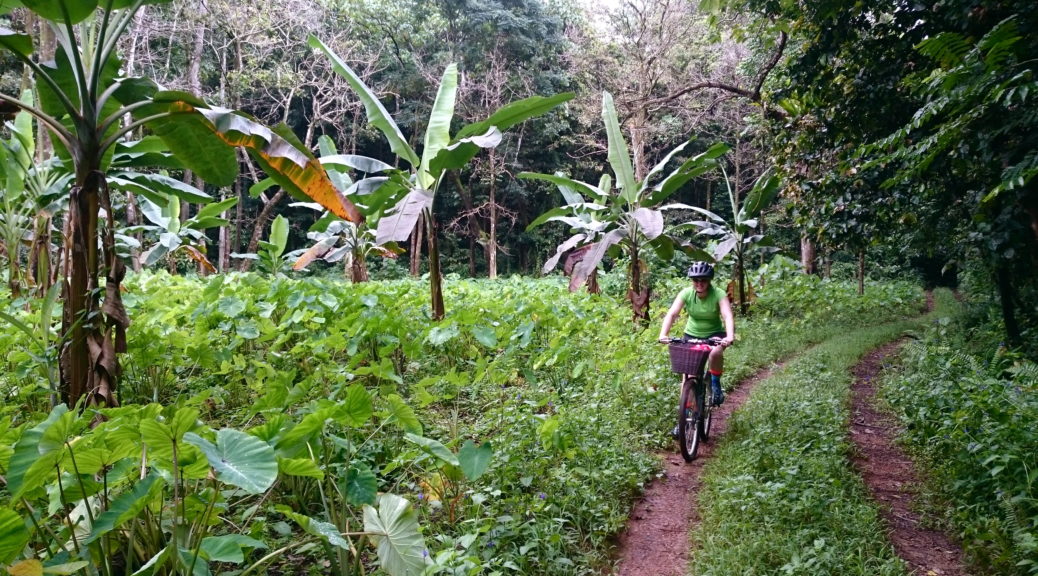


 We found more taro, and even a bit of papaya. The one we picked didn’t last so well in the basket.
We found more taro, and even a bit of papaya. The one we picked didn’t last so well in the basket. I found something to clamber over and #bikesrestingagainstearthmovingmachinery.
I found something to clamber over and #bikesrestingagainstearthmovingmachinery. With the briefest of showers, we reached the end of the trail and joined the perimeter road.
With the briefest of showers, we reached the end of the trail and joined the perimeter road.


 Plenty more derelict houses peppered the sights of the jungle.
Plenty more derelict houses peppered the sights of the jungle.


 My bike had not been consumed by the tropical forest in the time I was away.
My bike had not been consumed by the tropical forest in the time I was away.


 First explore – down the cave near Adele & James’s accommodation. There are a lot of limestone caves around the shore.
First explore – down the cave near Adele & James’s accommodation. There are a lot of limestone caves around the shore. A smattering of ferns down said-cave.
A smattering of ferns down said-cave. Happy not to climb down there into the surging ocean. Nice and clear, but.
Happy not to climb down there into the surging ocean. Nice and clear, but. A twenty or so minute walk through the jungle led us down to Talava Arches.
A twenty or so minute walk through the jungle led us down to Talava Arches. Looking out through and to Tavala Arches.
Looking out through and to Tavala Arches. Exploring the flats between the arches at low tide.
Exploring the flats between the arches at low tide. Typical jungle walking.
Typical jungle walking. Walking out through Palaha Cave to the sea.
Walking out through Palaha Cave to the sea. Looking out across to the edge of the reef.
Looking out across to the edge of the reef. A shower has passed. Those tsumani evacuation signs look familiar. Also shown: the general state of the few roads – that is, poor.
A shower has passed. Those tsumani evacuation signs look familiar. Also shown: the general state of the few roads – that is, poor. Near the end of the week, the sky cooperatively cleared for some decent sunsets.
Near the end of the week, the sky cooperatively cleared for some decent sunsets.
 Tamakoutoga Beach – one of the few sandy ones.
Tamakoutoga Beach – one of the few sandy ones. More beautiful pools at Avaiki Cave, and rather unconvincing proof that I did actually go in the water.
More beautiful pools at Avaiki Cave, and rather unconvincing proof that I did actually go in the water. John appreciating that Avaiki looks even better when the sunlight is shining directly into the entrance of the cave.
John appreciating that Avaiki looks even better when the sunlight is shining directly into the entrance of the cave. Avaiki Cave had something approaching a mezzanine level, good fun clambering up there and checking out the formations from a different perspective.
Avaiki Cave had something approaching a mezzanine level, good fun clambering up there and checking out the formations from a different perspective.

 Back to Matapa Chasm; this one has some fresh water flowing in so is cooler – but this time we had the sun directly overhead warming us, perfect.
Back to Matapa Chasm; this one has some fresh water flowing in so is cooler – but this time we had the sun directly overhead warming us, perfect. James up yet another coconut tree.
James up yet another coconut tree. Coconut catching was well practiced by this stage.
Coconut catching was well practiced by this stage. Final swim was at Limu Pools, especially good.
Final swim was at Limu Pools, especially good.